Biomedical Engineering Reference
In-Depth Information
again. There is approximately 1.2 L of air within the lungs that is used to keep the lungs
and the alveoli open under the most strenuous breathing conditions. The extra 1.2 L is
termed the residual volume of the lungs, which combined with the lung vital capacity sug-
gests that the total lung volume is 6 L (
Figure 9.5
).
During extremely strenuous activity
(when the lung is moving 4.8 L per breath), the respiratory rate can increase to approxi-
mately 50 breaths per minute. Under these conditions, the respiratory system would move
a total of 240 L of air per minute. In practice, only conditioned athletes can approach this
theoretical maximum respiratory rate.
We will provide a few more definitions that are associated with
Figure 9.5
. The expira-
tory reserve volume is the amount of air that can voluntarily be forced out of the lungs.
This is typically on the order of 1000 mL and is used during strenuous activities. The
inspiratory reserve volume is the amount of air that can enter the lungs in addition to the
tidal volume. On average this is close to 3300 mL, and again, this is used during strenuous
activities. As defined before, the total lung capacity would be the residual volume plus the
expiratory reserve volume plus the tidal volume plus the inspiratory residual volume
(1200 mL
6000 mL). The inspiratory capacity is the total
amount of air that can be taken into the lungs. This is equal to the tidal capacity plus the
inspiratory reserve volume (500 mL
1
1000 mL
1
500 mL
1
3300 mL
5
3800 mL). The vital capacity is the maxi-
mum amount of air that the lungs can take in or move out, which is equal to the expira-
tory reserve volume plus the tidal volume plus the inspiratory reserve volume
(1000 mL
1
3300 mL
5
4800 mL). The functional residual capacity is the amount
of air remaining in the lungs after a normal exhalation. This is equal to the residual vol-
ume plus the expiratory reserve volume (1200 mL
1
500 mL
1
3300 mL
5
2200 mL).
Assuming that atmospheric air is uniform, then all of the previous discussions on the
pressure changes required to move air into or out of the lungs are still valid. Again, pri-
marily Boyle's law will dictate the movement of air into the lungs.
1
1000 mL
5
FIGURE 9.5
The volume of the
lungs under normal breathing and
various other respiratory move-
ments. Under normal conditions, the
tidal volume will be approximately
500 mL for each breath and there is
an inspiratory reserve volume of
approximately 3300 mL and an expi-
ratory reserve volume of approxi-
mately 1000 mL. The total lung
volume is approximately 6000 mL.
Inspiratory
capacity
Inspiratory reserve
volume (IRV)
Vital
capacity
Tidal
volume
Total
lung
capacity
Expiratory
reserve
volume
(ERV)
Functional residual
capacity
Residual
volume
Time




























Search WWH ::

Custom Search